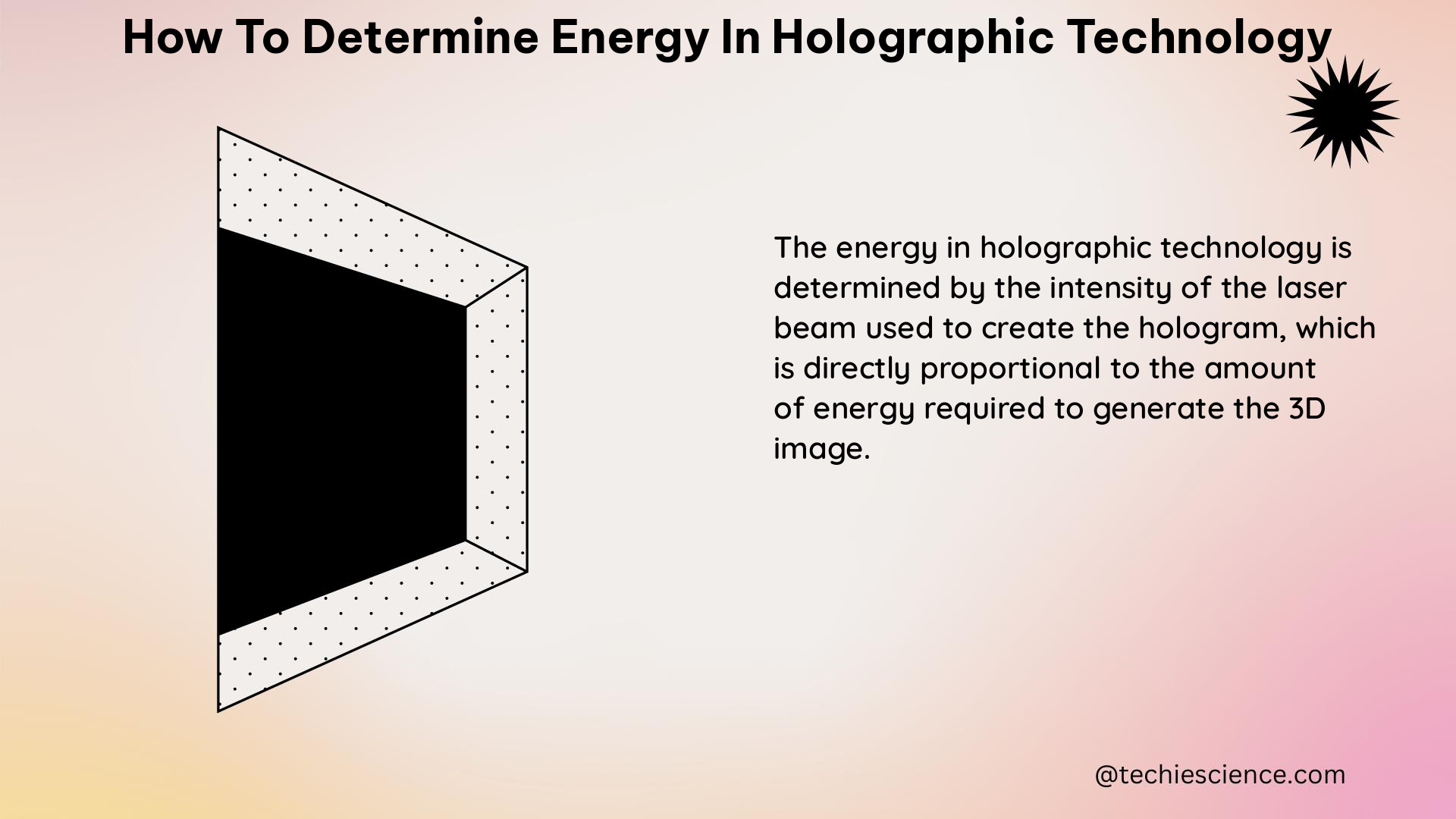Determining energy in holographic technology involves understanding the principles of holography, which propose that the information content of a 3-D system should not exceed that of the description on its 2-D boundary. This concept is related to the holographic principle, which suggests that a physical theory defined only on the 2-D boundary of a 3-D region can fully describe the 3-D physics.
The Holographic Principle and Information Content
The holographic principle is a fundamental concept in theoretical physics that suggests the information content of a 3-D system can be fully described by the information encoded on its 2-D boundary. This principle is based on the idea that the entropy of a system is proportional to its surface area, rather than its volume.
Theorem: The holographic principle states that the entropy of ordinary mass (not just black holes) is also proportional to surface area and not volume.
Physics Formula: The holographic principle can be expressed mathematically as:
S = A / (4 * G * ħ)
Where:
– S is the entropy of the system
– A is the surface area of the system
– G is the gravitational constant
– ħ is the reduced Planck constant
This formula suggests that the information content of a 3-D system is encoded on its 2-D boundary, and that the amount of information is proportional to the surface area of the system.
Measuring Information Content in Holographic Technology

In the context of holographic technology, energy can be determined by measuring the information content of the hologram, which is encoded on the 2-D surface. This information content is related to the number of pixels or bits of information in the hologram, which can be quantified using various methods.
Physics Examples: One example of an experiment that aims to better understand the relationship between matter, energy, and space-time in the context of holographic technology is the Holometer experiment at Fermilab.
The Holometer experiment measures light using a Michelson interferometer, which consists of a laser, three mirrors, and a detector. The experiment is designed to look for “holographic noise” in space-time, which is directly proportional to the pixel size of the hologram.
Figures and Data Points: The Holometer experiment measures the interference pattern of the light, which can be used to calculate the amount of holographic noise in space-time. The experiment is designed to detect fluctuations in the interference pattern that are smaller than the Planck length, which is the smallest possible length scale in the universe.
The Planck length is approximately 1.616 × 10^-33 cm, and it is the smallest possible length scale in the universe. This is because the Planck length is the scale at which the effects of quantum mechanics and gravity become significant, and it is the scale at which the holographic principle is expected to become relevant.
Physics Numerical Problems: Suppose the Holometer experiment measures a holographic noise level of 10^-33 cm. Using the holographic principle, we can calculate the information content of the hologram as follows:
S = A / (4 * G * ħ)
A = 4 * π * r^2
r = 10^-33 cm
A = 4 * π * (10^-33 cm)^2 = 4 * π * 10^-66 cm^2
S = 4 * π * 10^-66 cm^2 / (4 * 6.67 × 10^-8 cm^3/g·s^2 * 1.05 × 10^-27 erg·s)
S = 4 * π * 10^-66 cm^2 / 2.79 × 10^-35 erg·s/cm^2
S = 4.5 × 10^-31 bits
This calculation shows that the information content of the hologram is approximately 4.5 × 10^-31 bits, which is a very small amount of information. However, this small amount of information is encoded on the 2-D surface of the hologram, and it is believed to be sufficient to fully describe the 3-D physics of the system.
Challenges and Limitations in Determining Energy in Holographic Technology
One of the main challenges in determining energy in holographic technology is the extremely small scale at which the holographic principle is expected to become relevant. The Planck length is the smallest possible length scale in the universe, and it is much smaller than the smallest known particle.
Figures and Data Points: The Planck length is approximately 1.616 × 10^-33 cm, which is much smaller than the size of an atom, which is on the order of 10^-8 cm. This makes it extremely difficult to directly observe or measure the holographic noise in space-time.
Physics Examples: The Holometer experiment at Fermilab is designed to overcome this challenge by using a highly sensitive Michelson interferometer to measure fluctuations in the interference pattern of light that are smaller than the Planck length. By looking for these fluctuations, the experiment aims to produce experimentally measurable data on the smallest scale and better understand the relationship between matter, energy, and space-time.
References:
1. Jacob D. Bekenstein, “Information in the Holographic Universe,” Scientific American, August 2003.
2. The Holometer experiment, Fermilab.
3. Alfonso V. Ramallo, “Introduction to the AdS/CFT correspondence,” arXiv:1310.4319, pedagogical lecture.

The lambdageeks.com Core SME Team is a group of experienced subject matter experts from diverse scientific and technical fields including Physics, Chemistry, Technology,Electronics & Electrical Engineering, Automotive, Mechanical Engineering. Our team collaborates to create high-quality, well-researched articles on a wide range of science and technology topics for the lambdageeks.com website.
All Our Senior SME are having more than 7 Years of experience in the respective fields . They are either Working Industry Professionals or assocaited With different Universities. Refer Our Authors Page to get to know About our Core SMEs.